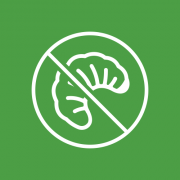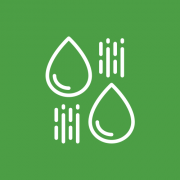Proven and Effective Treatment
Grub Prevention & Control Services
Is Your Lawn Suffering From Any of the Below Issues?
- Dead patches of lawn, brown, spotty. Almost burnt looking
- Wildlife digging up your grass in search of grubs
- Mounds of turf that look like they have been clumped together
- You’re easily able to peel back the turf and can see the roots are not holding
- Lawn feels soft and/or squishy when walked on

Then you most likely have a grub problem. At Pure Solutions, our grub control solution is both preventive and curative, without the use of harsh toxic chemicals.

Pure Solutions utilizes a naturally occuring bacillus thuringiensis, a proven and effective treatment for eliminating the larvae of:
View Types of Larva
- Annual bluegrass weevil (Listronotus maculicollis)
- Asiatic garden beetle (Maladera castanea)
- European chafer (Rhizotrogus majalis)
- Green June beetle (Cotinis nitida)
- Japanese beetle (Popillia japonica)
- May or June beetle (Phyllophaga sp.)
- Northern masked chafer (Cyclocephala borealis)
- Oriental beetle (Anomala orientalis)
- Southern masked chafer (Cyclocephala lurida)
- Black Turfgrass Ataenius (Ataenius spretulus)

Naturally occuring bacillus thuringiensis is safe to be used for applications on:
Approved Areas for Application
- Residential lawns
- Golf courses (e.g. greens, tees, collars, roughs, and fairways)
- Commercial grounds (e.g. office, shopping complexes and airports)
- Parks
- Schools
- Playgrounds
- Athletic fields
- Daycare facilities
- Pet care facilities
- Cemeteries
- Sod farms
- Other turf grass-covered areas

When Should You Apply Pure Solutions Natural Grub Control?
Late June through August is the most effective time for treatment. Your Pure Solutions grub or beetle treatment not only removes the damaging grub larvae from your lawn but also acts as a deterrent to future grub or beetle populations.
If you notice large brown dead areas on your lawn, or see signs that your lawn may have been dug up by an animal, then you may have a grub problem. At Pure Solutions we have over a decade of experience in dealing with grubs in an effective, natural and safer way, giving you peace-of-mind that you are not exposing yourself, friends, family or pets to harmful toxic chemicals.
Want to learn more about dealing with Grubs naturally? Do you need a quick free estimate for Grub Control? Then simply fill out the form below or call us at 781-899-7873.
Get a Digital Quote Today!
At Pure Solutions Grub & Beetle Control is Simple.

Inspect
A Pure Solutions Field Specialist will visit your property to inspect and analyze your lawn for beetle and/or grub activity.

Apply
Your Pure Solutions Field Specialist will apply our all-natural grub control product to your entire lawn just prior to the egg-hatching season.

Water
Frequent watering will be needed to help the organic grub control treatment absorb into the root zone.

Enjoy Your Beautiful Lawn!
Our all-natural grub control product will remain in the root zone and will eliminate any white grubs that hatch and feed on your turf’s roots. Resulting in a green, beautiful, grub free lawn without the use of toxic chemicals!
Frequently Asked Questions
When to apply grub control to lawn?
Grubs are beetle larvae that can damage lawns by feeding on grass roots. To prevent this damage, it is important to apply grub control at the right time. The timing of application depends on the species of beetle present in your area and the stage of their life cycle. In general, the best time to apply grub control is in late summer or early fall, when the grubs are small and actively feeding near the soil surface. This is usually between late July and mid-September in most regions. Applying grub control during this time will help prevent damage to the lawn in the following spring and summer.
How to control grubs in lawn?
Pure Solutions uses a naturally occurring bacteria called Bacillus thuringiensis (Bt), which specifically targets the larvae of various beetle species, including Japanese beetles, June beetles, and chafer beetles. When the grubs ingest the granules, the Bt bacteria produces a toxin that paralyzes their digestive system, leading to their eventual death. Grub Gone is a safe and effective way to control grubs without harming beneficial insects, pets, or humans, making it an excellent choice for homeowners who want to maintain a healthy, thriving lawn and garden.
What animal eats grubs at night?
Lawn grubs are a common pest that can cause damage to lawns by feeding on grass roots. Fortunately, there are several animals that may eat lawn grubs, including skunks, raccoons, opossums, moles, and certain birds. Skunks are notorious for digging up lawns to feed on grubs, while raccoons and opossums may also feast on these pests. Moles primarily feed on earthworms, but may also eat lawn grubs, and certain birds such as starlings and grackles may also feed on them. While these animals may help control the population of lawn grubs, they may also cause damage to lawns in the process, so it's important to balance pest control with responsible lawn management practices.
Will grass killed by grubs come back?
If grass is killed by grubs, it may or may not come back, depending on the severity of the damage and the extent to which the roots have been affected. Grubs are the larvae of certain types of beetles and can cause damage to grass roots by feeding on them. If the damage is minimal, the grass may be able to recover on its own. However, if the damage is more severe, the grass may not be able to regenerate on its own, and you may need to take action to help it recover. This could include reseeding or laying new sod.
Do grubs come out after rain?
It is possible for grubs to emerge or become more active after rainfall. Grubs are the larval stage of various beetle species and they typically live in soil, feeding on the roots of plants. When there is rain, the soil becomes moist and this can stimulate grubs to move closer to the surface of the soil. Additionally, rain can help to bring plant roots closer to the soil surface, which may attract grubs to feed on them.
How do I know if my lawn is infested with grubs?
If you notice brown patches on your lawn that don't respond to watering or fertilizing, it may be a sign that your lawn is infested with grubs. Grubs are the larvae of various beetles, including Japanese beetles and chafer beetles, and they feed on the roots of grasses, causing them to die. You may also notice small, irregularly shaped holes in the soil where birds, skunks, or other animals have been digging to feed on the grubs. To confirm that your lawn is infested with grubs, you can dig up a small section of turf and examine the soil and roots for the presence of small, white or grayish-brown, C-shaped grubs. If you find more than five grubs per square foot of turf, you may need to take action to control the infestation and prevent further damage to your lawn.
Pure Solutions offers New England’s #1 organic lawn care services, including grub prevention & control services, organic lawn fertilizer service, lawn seeding services, lawn aeration service, compost spreading service. Pure Solutions also proudly offers all natural tick control and mosquito control, all-natural deer repellent, botanical pest control products, special event pest control, and even commercial snow plowing. We satisfy customers across New England including Central New Hampshire, Upper Valley, Rhode Island, and Massachusetts, including Martha’s Vineyard and Cape Cod.
